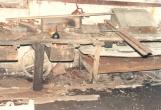1
In 1990 the Trinity Historical Society received as a gift the Green Family Forge from Mrs. Ada Nemec.The forge had been closed since 1955 when Andrew Green, the last blacksmith in the family closed up the business. He closed the smithy in August and he passed away in November.
Ada simply had the building boarded up and that was the way it was until 1990.
After the Society received the building they accessed a grant from Human Resources Development Canada and hired a work crew to have the building restored and the artifacts cleaned for visitors.
The building opened in 1992.
2
The work crew who restored the Green Family Forge.February, 1991
Trinity, Newfoundland and Labrador, Canada
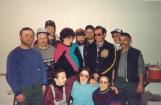
3
A grant from the Canada Employment Commission in February and March 1991 provided the means for the restoration of the forge. Six male and five female workers were employed to stabilize the structure from the foundation up, with all new claboard, windows and doors. A portion of the roof was replaced, two old fireplaces were rebuilt as well as the artifacts made from iron, steel, brass and copper were all cleaned and dipped in a preservative solution. The artifacts were then catalogued for display.A student grant was obtained for that summer, 1991, and three students operated the museum during July and August. They saw 4,840 people in the nine weeks that it was opened. Eighteen bus tours accounted for another 298 people for a grand total of 5,138. On average 571 per week or 82 per day.
4
During the restoration process Mr. Rupert Morris, President, Trinity Historical Society kept a daily diary of the work that was carried out. On that first morning he wrote the following entry:Feb 11, 1991 - The following persons began work today - Colin Hayter - foreman; Clarence Locke; Phil Mackey; Ephriam Hiscock; Scott Hurdle; Bill Hiscock; Sylvia Hiscock; Rachael Earle; Felicity Goldsworthy; Yvonne Hayter and Gail Ploughman.
All met at the Development Assocation office for an explanation of the work to be done. The men began to brace the chimney before attempting to take it down and the women began to move the old lumber to another storage area.
Other entries detailed the day-to-day work:
Feb 12, 1991 - The men began to dismantle the chimney. The women removed some of the clapboard from the front and south side of the building and helped with the carrying and sorting of the brick. They later began cleaning the bricks.
Feb 13, 1991 - No work due to a snow storm
Feb 14, 1991 - Women cleaning the bricks as well as boxing the artifacts to be taken to another building to be cleaned. Men stripping off old clapboard and repairing/replacing with new boards.
5
Part of the interior of the Green Family Forge before restoration work began.1990
Green Family Forge,Trinity, Newfoundland and Labrador, Canada
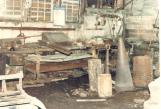
6
The forge usually had one or two workbenches for various kinds of work to be carried out.In the Green's forge there was only one long bench that had all the tools that were necessary to carry out the work that was required.
Often times one side of the bench would have tools that were used to repair cart wheels etc.. such as hammers, saws, chisels, planes, drawknifes and spokeshaves. Whereas on another part of the bench there would be tools for finishing work after the forging was completed. The tools there were files, shears, punches, cold chisels etc.
8
The back of one of the chimney's in the Green Family Forge showing the bellows and water tank.February, 1991
Green Family Forge,Trinity, Newfoundland and Labrador, Canada
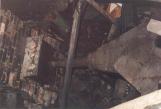
9
The water tank on the back of the chimney would be filled with water in order to keep the back of the chimney cool, as well as the air nozzle that went from the bellows into the fire.Water for this tank would come from the small shallow well that was located in the back of the forge. This well was also used to supply the water that was needed for the cooling of the forged items, water for the slack tub, as well as for visitors to the forge, human and horses, either for a cool drink or to boil the kettle.
10
Water tank on the back of one of the chimney'sFebruary, 1991
Green Family Forge,Trinity, Newfoundland and Labrador, Canada
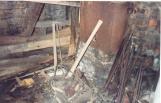
11
The coal storage bin in the forge.February, 1991
Green Family Forge,Trinity, Newfoundland and Labrador, Canada
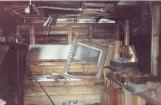
12
Coal was a very precious commodity as the coal boat only came to Trinity twice a year. Enough coal would have to be taken off in between trips to last until it arrived again. People would go to the government wharf with their horse and cart and get large wooden tubs filled with coal to bring back to their homes and businesses to place in such large bins as this one.13
One of the writing desk that was found in the forge.February, 1991
Green Family Forge,Trinity, Newfoundland and Labrador, Canada

14
Part of the forge and chimneyFebruary, 1991
Green Family Forge,Trinity, Newfoundland and Labrador, Canada

